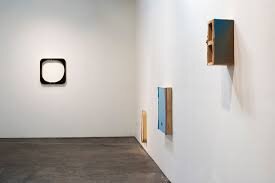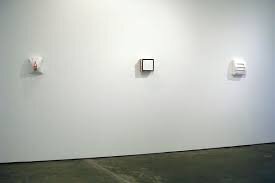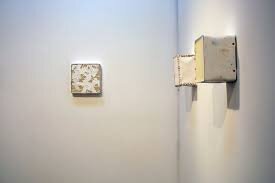Five Questions for Artist Jeff Conefry
Jeff Conefry
Five Questions
Other People’s Words:
“One has the sense that the artist is pulling back the curtain on the artistic process to allow us to see how he explores the limits and possibilities of his material. “Paint” allows Conefry’s audience to share in the sense of discovery and creation, following along as Conefry finds new ways to take those basic four materials and reimagine them. ”
Five Questions:
Interviews in Excellence with Artist
Jeff Conefry
Pinky, Jeff Conefry.
1. How do you get in the right mindset to make your work? Do you have a particular strategy?
A mindset necessary for making work is usually a product of opportunity. I crave a consistent physical practice, the noise associated with an art life can easily drown out intention. I have responsibilities I gladly attend to in order to maintain a life as complete as possible.
I live and work in Greenpoint Brooklyn, which by nature possess some of the most stressful economic realities that any artist can face. Dealing with this reality among others relies on an ability to put into compartments all the various desperate elements associated with an art life. The more separate your concerns are the greater the ability to overcome any one challenge at a time.
This structure relies on making lists and schedules as the only hope in combating the chaos that surrounds us. It is not a perfect system because I make it and that’s fine. You can only persevere to get your mind right more often than not.
Spread, Jeff Conefry.
2. What process do you go through in preparing for a work that you are about to make? (drawing,sketching, writing, experimenting, etc...)
Preparations for making new work relies on failure. Sometimes you go through failure in order to reach a specific outcome. Sometimes you embrace failure as a much better solution than what you presupposed.
3. What does an ideal studio day look like for you?
I prefer the structure of the regular work day. I’m not a morning person, but I don’t like to linger at home. I drink my coffee, pet the cats, and move on. I love my neighborhood and I have the luxury of walking to my studio. I like walking down along the east river past all the towers under construction seeing through to the skyline of Manhattan beyond. I like seeing the streets, the trees, the cars, the people walking their little dogs. I like seeing new graffiti and cool stuff in the garbage. I get my snacks and food for the day. I don’t like to leave once I arrive.
At the studio I turn on the lights and the computers. I always look out the window at the Newtown Creek with Long Island City beyond and exhale. I’m very grateful. I go to see the results of the previous days work. I check my head and see where I am. My brain does not work the same from day to day, therefore I must take note of where I’m at and try to see what I am best suited to deal with that day. Sometimes I am merely a drone continuing an already designed process or I suddenly have the solution to every problem yet unsolved.
I work at something to the point that continuing might ruin it, so I try to leave it and move on to something else. I like to doodle in my notebook and flesh out spatial ideas on the computer. I order things I need, eat my lunch, and read the news. I calculate what is achievable before I am no longer useful and need to go home.
I feel satisfied getting things done. I don’t have to finish everything on the list, but there does have to be progress on some level. I always end the work day by taking inventory of the days work and setting the goals for tomorrow.
If it is still light out, On the walk home I like to go to the secrete park on the river and watch the sun set over Manhattan. I like to clear my mind and put the struggles of the day aside. It is this quiet mental time outside of the studio that helps generate solutions in the studio.
S is for Space, Jeff Conefry.
4. What is your favorite piece that you have made and why?
I can’t really say I ever totally trust my personal opinion of my work. Of course I like some things more then others, it’s just that I am personally quite critical and tend to problem solve ahead for the next piece.
That said, I have been spending a lot of time reflecting on this piece.
Flat Land Monster, Jeff Conefry.
It’s title is in flux at the moment.
It started as a painting I finished a couple years ago that never felt done. It just seemed like a waste of some good parts still worth holding onto. Last year I had a museum show opportunity that would allow me some freedom to present some floor pieces. I have been trying to find an approach to the floor that interested me for quite a few years without much love. I pulled some old work out and found myself surrounded by several crappy pieces full of plenty of good parts. So I tried to play a bit and have fun with the parts and found a kickstand to help round out this current piece.
It’s strange and funny. It has some good parts and feels like it makes visual sense, so I like it. I won’t burden you with the things I think could be better. A title could always help. I sometimes think of it as a collection of functional failures. Sometimes it seems like a Tiktaalik , the first fish known to walk on land, and other times it seems like a Flatland Monster referenced in “Flatland”, a book by Abbott. These three approaches show the dilemma I have in seeing how I want a piece like this to move forward.
“Untitled”, break, Jeff Conefry.
5. If you could hang your work next to any other artist’s work (past or present) whose work would it be? What piece in particular?
First artist to come to mind is Anish Kapoor. He recently had a show of mirrored pieces at Lisson Gallery. I really love these pieces. I would like to see one of those in relation the piece of mine I spoke of earlier.
Kapoor’s pieces are well conceived, well made, basically perfect. These attributes seem to function in polar opposition to the piece I would present along with it. Even though I feel my work functions as a kind of mirror for the viewer, Kapoor’s context would ultimately help my work seem odder, kind of shitty, and bit more punk rock. I’d be good with that.
Bending, Jeff Conefry.
Recent Exhibitions:
2020
“IMAGE_OBJECT (THE VISUAL AND THE PHYSICAL)”, Poimena Gallery, Austrailia, January 16 to February 27, 2020
2019
Kunst, X-Pinky LAB, Zürich. October 23, 2019
Others, X-Pinky LAB, Turin. October 30, 2019
Zuckerman Museum of Art, Kennesae GA. August, 2019
Scope, X-Pinky LAB, New York. March 15, 2019
2018
Kathryn Markel Fine Arts, New York, October 25 to December 1, 2018
Solo Exhibition , Marcia Wood Gallery. Atlanta. September 12, 2018
artBangall, Bangall NY, June 2, 2018
Gallery Weekend, X-Pinky LAB, Berlin, April 28, 2018
International Independent Art Fair, New York. April 28, 2018









